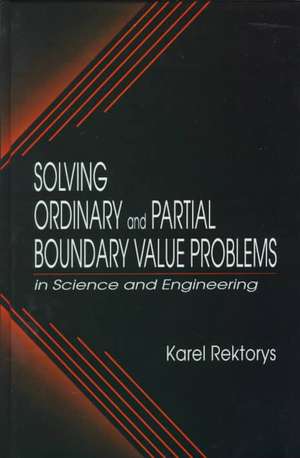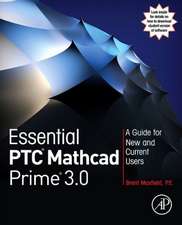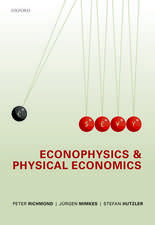Solving Ordinary and Partial Boundary Value Problems in Science and Engineering: Applied and Computational Mechanics
Autor Karel Rektorysen Limba Engleză Hardback – 20 oct 1998
Discussions include:
The author presents special remarks for the mathematical reader, demonstrating the possibility of generalizations of obtained results and showing connections between them. For the non-mathematician, the author provides profound functional-analytical results without proofs and refers the reader to the literature when necessary.
Solving Ordinary and Partial Boundary Value Problems in Science and Engineering contains essential functional analytical concepts, explaining its subject without excessive abstraction.
Din seria Applied and Computational Mechanics
- 9%
 Preț: 911.85 lei
Preț: 911.85 lei -
 Preț: 370.62 lei
Preț: 370.62 lei - 29%
 Preț: 961.40 lei
Preț: 961.40 lei - 26%
 Preț: 875.97 lei
Preț: 875.97 lei - 30%
 Preț: 780.53 lei
Preț: 780.53 lei - 28%
 Preț: 1065.94 lei
Preț: 1065.94 lei - 29%
 Preț: 1032.68 lei
Preț: 1032.68 lei - 18%
 Preț: 855.24 lei
Preț: 855.24 lei - 18%
 Preț: 907.47 lei
Preț: 907.47 lei - 20%
 Preț: 1074.48 lei
Preț: 1074.48 lei - 15%
 Preț: 702.46 lei
Preț: 702.46 lei - 18%
 Preț: 1404.67 lei
Preț: 1404.67 lei - 20%
 Preț: 829.94 lei
Preț: 829.94 lei - 18%
 Preț: 1334.90 lei
Preț: 1334.90 lei - 18%
 Preț: 1260.78 lei
Preț: 1260.78 lei - 18%
 Preț: 1009.60 lei
Preț: 1009.60 lei - 29%
 Preț: 1181.74 lei
Preț: 1181.74 lei - 28%
 Preț: 993.44 lei
Preț: 993.44 lei - 31%
 Preț: 690.52 lei
Preț: 690.52 lei
Preț: 782.44 lei
Preț vechi: 954.19 lei
-18% Nou
Puncte Express: 1174
Preț estimativ în valută:
149.72€ • 156.74$ • 123.88£
149.72€ • 156.74$ • 123.88£
Carte tipărită la comandă
Livrare economică 07-21 aprilie
Preluare comenzi: 021 569.72.76
Specificații
ISBN-13: 9780849325526
ISBN-10: 0849325528
Pagini: 224
Ilustrații: 1 table and 973 equations
Dimensiuni: 156 x 234 x 18 mm
Greutate: 0.45 kg
Ediția:1
Editura: CRC Press
Colecția CRC Press
Seria Applied and Computational Mechanics
Locul publicării:Boca Raton, United States
ISBN-10: 0849325528
Pagini: 224
Ilustrații: 1 table and 973 equations
Dimensiuni: 156 x 234 x 18 mm
Greutate: 0.45 kg
Ediția:1
Editura: CRC Press
Colecția CRC Press
Seria Applied and Computational Mechanics
Locul publicării:Boca Raton, United States
Public țintă
Academic, Postgraduate, and ProfessionalCuprins
Ordinary Differential Partial Equations with Boundary Conditions - Eigenvalue Problems. Partial Differential Equations - Classical Approach. Variational Methods of Solutions of Elliptic Boundary Value Problems - Generalized Solutions and Their Approximations - Weak Solutions. The Finite-Difference Method for Partial Differential Equations - The Method of Discretization in Time (the Rothe Method). The Fourier Method.
Recenzii
"Numerous technical and physical examples explained in a very clear manner help to understand better theoretical material and motivate further exploration of the subject. Accumulating many years of the author's teaching experience at the Technical University of Prague, this excellent book will be of benefit for engineers, scientists, and mathematicians dealing with boundary value problems, as well as students of science and engineering."
-Yuri V. Rogovchenko (Famagusta), Zentralblatt Math, Vol. 1078, April 2006
"A very nice text...addressed to the non-mathematician."
- Ivo Babuska, Professor of Engineering and Mathematics, University of Texas
"This book is unusual in that it sits at the intersection of differential equations and numerical analysis, and in this regard it represents a modern approach to the subject. A good discussion…"
-CHOICE, May 1999
-Yuri V. Rogovchenko (Famagusta), Zentralblatt Math, Vol. 1078, April 2006
"A very nice text...addressed to the non-mathematician."
- Ivo Babuska, Professor of Engineering and Mathematics, University of Texas
"This book is unusual in that it sits at the intersection of differential equations and numerical analysis, and in this regard it represents a modern approach to the subject. A good discussion…"
-CHOICE, May 1999
Descriere
This book provides an elementary, accessible introduction to the concepts of ordinary and partial boundary value problems, acquainting readers with fundamental properties and efficient methods of constructing solutions or satisfactory approximations. The author motivates the mathematical theory by introducing useful technical or physical examples and presents special remarks for mathematical readers that demonstrate the possibility of generalizing the results obtained. For non-mathematicians, the author provides functional-analytical results without proofs and refers readers to the literature for further details. Numerous exercises complement each chapter.













